Mrs Mayes
Mrs Mayes also had a boarding school for young ladies in the Market Place at the same time as Miss Mabley and advertised in the same way. This is her advertisement of about 1856:
Mrs Mayes receives young ladies to instruct in the usual branches of an English Education
Terms: For Boarders £16 per annum, washing an extra charge
Day Pupils, Half a Guinea per quarter
Writing and arithmetic 8s. 0d.
French 10s.0d.
Music 10s. 0d.
Drawing 10s.0d.
Each young lady to be provided with a Knife and Fork, Dessert Spoon and six towels.
A Quarter’s Notice required previous to the Removal of a Pupil
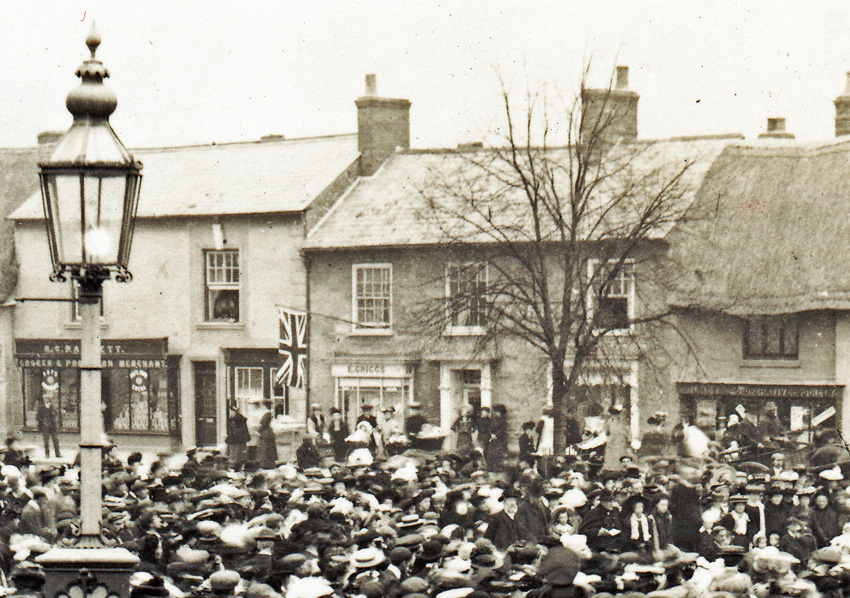
Mrs Mayes’ School is believed to have occupied 19 Market Place (Photograph 1900s)
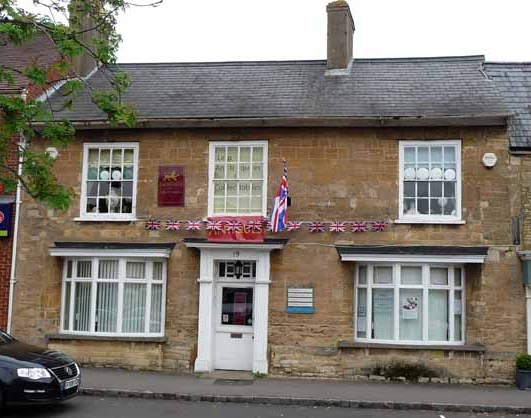
No 19 Market Place (Photograph 2013)
It would appear that Mrs Mayes closed her school when her husband died, but decided to re-open it later as the following advertisement indicates:
Mrs Mayes establishment for young ladies, Market Place, Olney.
In resuming her school duties and appealing to her former friends to continue their support, MRS MAYES believes she has only to remind them of her late painful bereavement to secure their sympathy.
Mrs Mayes trusts she feels very grateful for past favours, and hopes none will withdraw their confidence as she hopes by increased attention to her pupils to secure a larger number of scholars.
Terms: Pupils above 8 years of age 1s.0d. per week
Under eight and above six 9d. per week
Under six 6d.per week
Weekly boarder 4s.0d. per week
Daily 2s.0d. per week
French 10s.0d. per quarter
Music 10s.0d. per quarter
Drawing 10s.0d. per quarter
There was a Thomas Mayes, tailor on the Market Place in 1821 and a John Mayes, tailor in 1851, both appeared to reside on the East side of the Market Place, probably at No.19. So hopefully we can assume that this was also the site of Mrs Mayes’ school.
Elizabeth Kitchener & Rebecca Berrill
An Elizabeth Kitchener, was running an Infant’s School on the South side of the Market Place, according to Pigott’s Directory of 1842, and may well have been the school mistress that Hugh Miller met on his visit to Olney a few years later. (Details below.) This was confirmed by an entry In Walter Pennington Storer’s unpublished manuscript notes:
Friday December 29th 1848
“Mrs Kitchener the late Mistress of the Olney Infant Schools (held at Cowper’s House) suddenly fell from her chair and died.”
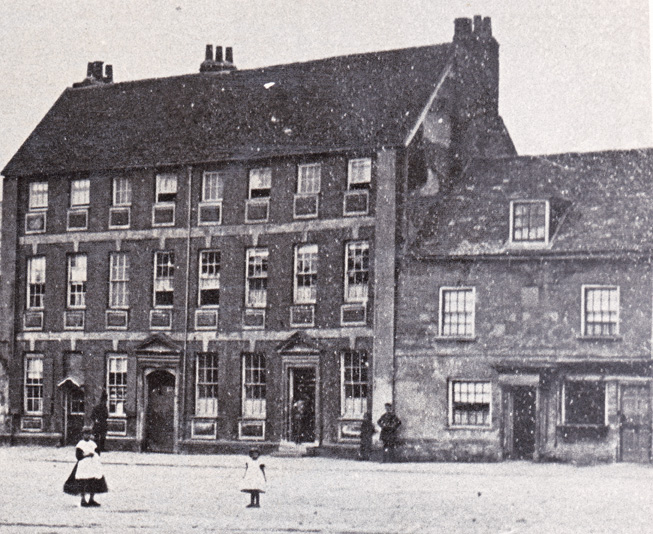
Rebecca Berrill’s school occupied the house on the right. (Photograph 1850s)
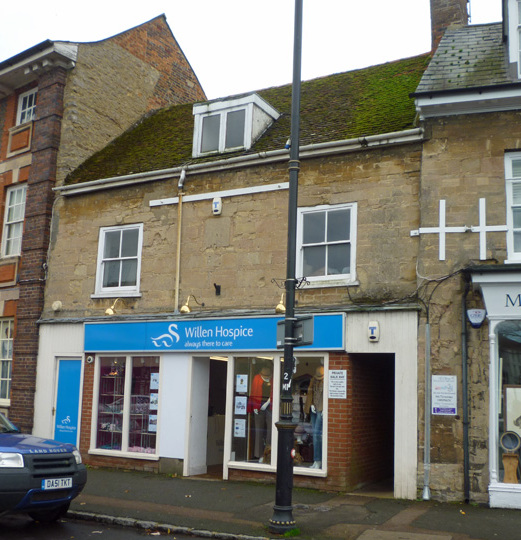
No 31 Market Place (Photograph 2014)
By the 1851 Census the property had been taken over by, yet another Seminary for Young Ladies, with both boarding and day pupils. Rebecca Ann Berrill, a 36 year old spinster was now running her establishment from the Market Place. Ten years previously, she had been at an unknown location in the High Street of Olney. On that Census night Miss Berrill had two female visitors both ‘annuitants’ in their fifties (ladies with their own money!). Sarah Ann Burton was a teacher there with six pupils. The pupils were two sisters from Bedford aged fourteen and ten, an eleven year old girl from Harrold, and nine and six year old pupils from Toddington and Wymin[g]ton in Bedfordshire. A ten year old pupil from Kimbolton had a sixteen year old relative visiting her that night. There was one servant from Emberton.
Jane Baker
On the west side of the Market Place, Jane Baker had a small school. She was the young widowed daughter-in-law of Samuel Baker, the Innkeeper of the Bull. Jane’s husband, also Samuel , had died in 1841 at the young age of 27. Possibly the Innkeeper felt responsible for his daughter-in-law, so offered her a home with him, but obviously she had to support herself, so having plenty of rooms at the Bull, she was offered one for a school – this might have been a small private ‘dame’ school for young children.
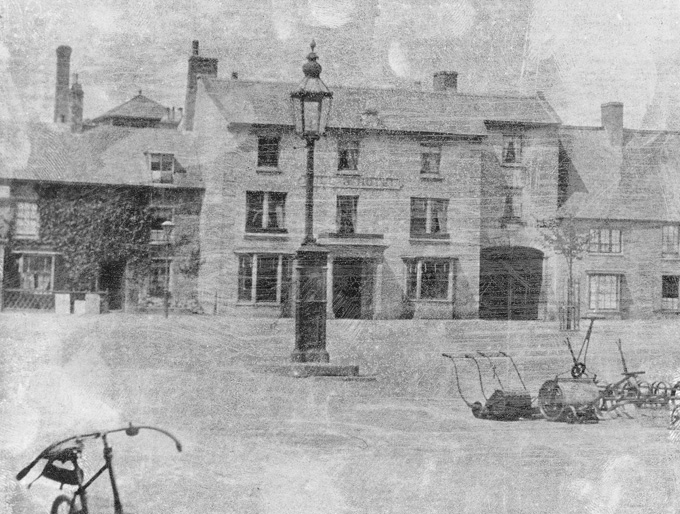
Jane Baker’s school was situated in the Bull Hotel (Photograph 1890s)
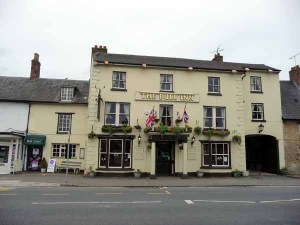
The Bull Hotel (Photograph 2013)
Lace Schools
The 1851 Census revealed two other small day schools with a single teacher, possibly both ‘lace schools’, where young girls were taught to make lace. It was well known that they were rarely taught to write as this would take their hands away from their lace pillows. Whereas they could learn to read from charts on the wall or in brief one-to-one sessions with the teacher, often using the Bible for a teaching aid! Discipline was very strict, with the girls’ hair tied back, so no stray hairs got worked into the lace. Necks had to be bare, so they could be slapped if they did their work was incorrect. If their lacemaking was particularly badly done, their head would be pushed down and their nose rubbed on the pinheads. To keep up a steady rhythm to their work, the children would chant ‘lace tells’, often starting with the number nineteen and counting down to one, at which they would shout out with relief ‘my glum’s done’!
One lace tell starts off:
‘Nineteen miles have I to go –
Eighteen miles have I to go –
Seventeen miles have I to go –
and so on downwards, a pin being stuck in the pattern on the pillow at each number.
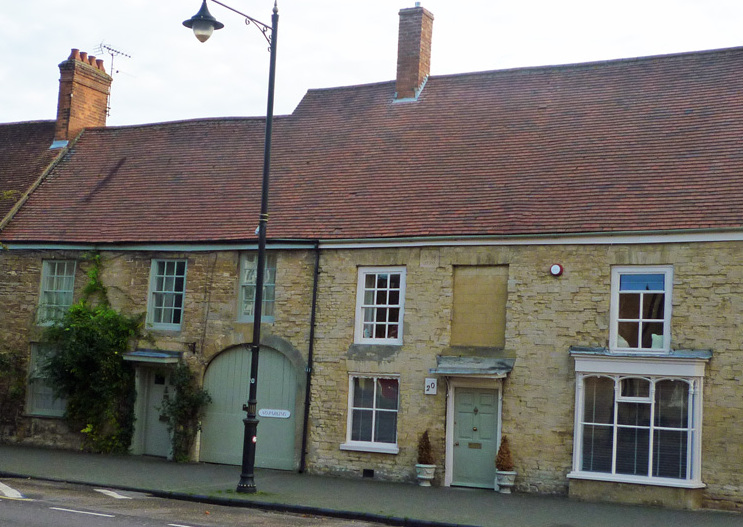
Nos 22 & 20 High Street (Photograph 2014)
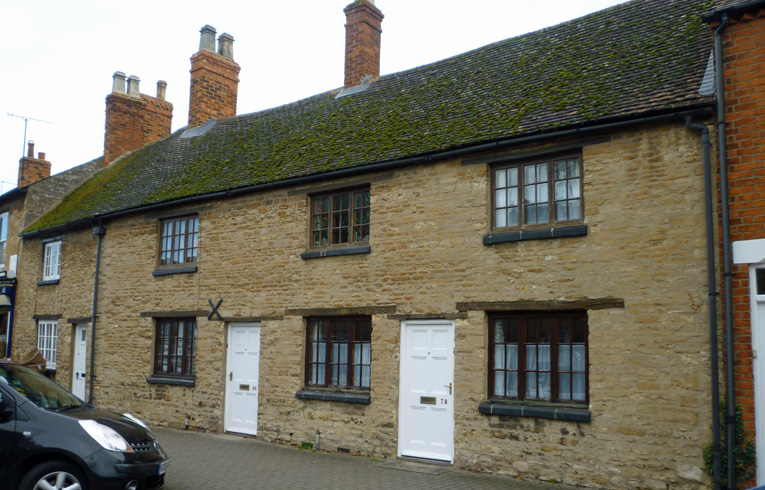
Nos 78 to 82 High Street (Photograph 2014)
Sarah Duxbury ran one such school in the vicinity of 20 or 22 High Street. The other was listed in the Census as a ‘School of Lacemaking’ and was run by Ann Longland in a cottage similar to the present day Nos 78 to 82 High Street. Both school mistresses were unmarried and aged 60 and 50 years of age respectively.
In the Preface to the little booklet ‘Mary’s Grave’, printed and sold by T.Collingridge in 1836 ‘for the benefit of the Olney Infant, Sewing and Lace Schools, held in Cowper’s House’, it states:-
‘These Schools are managed by Three Mistresses, superintended by the Clergymen and other friends as visitors, and are dependent upon the profits derived from an occasional Bazaar on a small school, and from the Voluntary Contributions which the ‘Donation Boxes’ receive, in addition to the Children’s pence. The Schools contain about Ninety Children, to whose religious and moral education, considerable attention is paid. Perhaps therefore the object in committing this tale to the press, will silence the criticism which might otherwise be due to a merely juvenile production.’
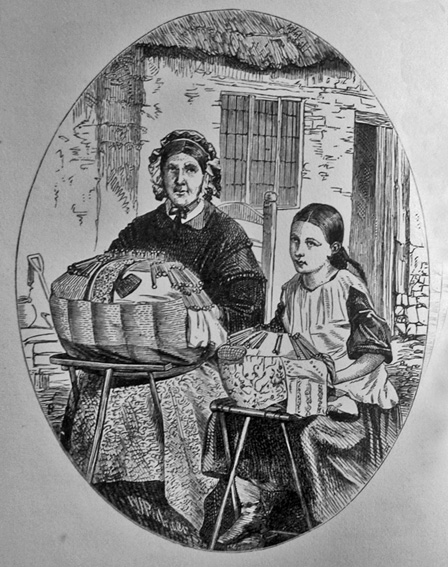
An illustration from Elizabeth Wilson’s 1864 book called ‘Olney and The Lacemakers’
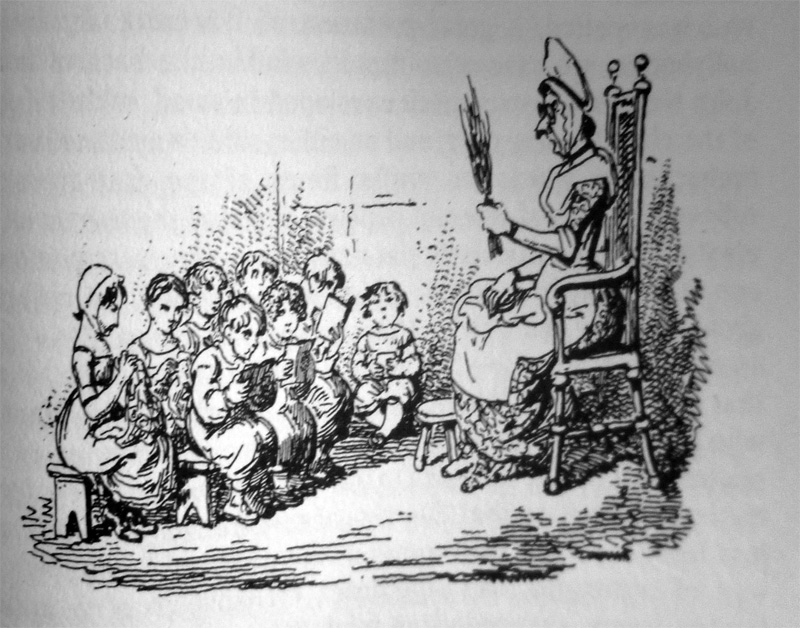
An artist’s impression of the infant school, Hugh Miller found in the Parlour of Cowper’s House in 1845
There is evidence of a continual use of Cowper’s house (Nos 29/30 Market Place) as an infant school of some form from Hugh Miller’s visit in 1845. Hugh Miller was a Scottish geologist who described his travels through England in his book ‘First Impressions of England and its People’ published a year later. He wrote: ‘… we see an old-fashioned house, considerably taller than the others and differently tinted; for it is built of red brick, somewhat ornately bordered with stone. And this tall brick house was Cowper’s home for nineteen years. It contains the parlour which has become … a standard paragon of snugness and comfort … I found the famed parlour vocal with gabble of an infant-school: carpet and curtains were gone, sofa and bubbling urn; and I saw, instead, but a few deal forms and about two dozen chubby children, whom all the authority of the thin old woman, their teacher, could not recall to diligence in the presence of the stranger.’
It is of course possible that Hugh Miller was referring to the Lace School of Ann Brittain, as advertised in 1844, that occupied Number 30. Moreover, the above caricature could indeed be of Ann Brittain.
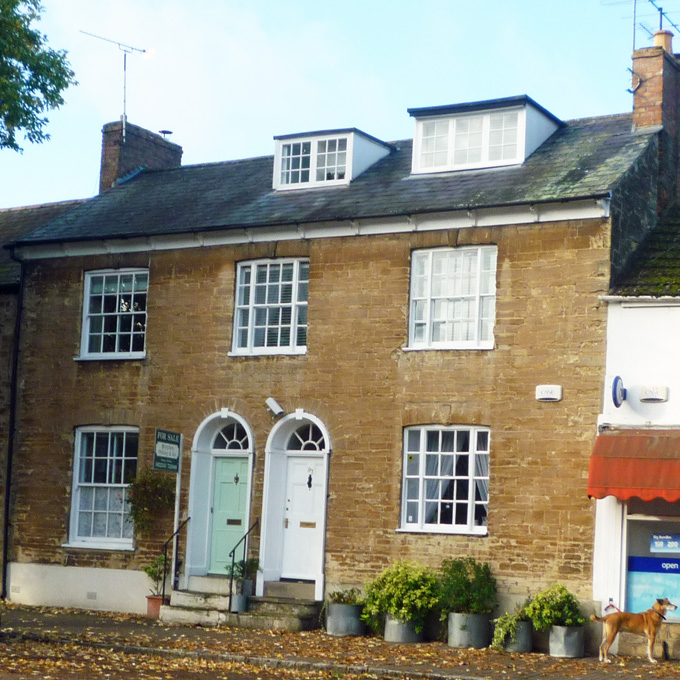
Nos 95 & 97 High Street (Photograph 2014)
Mrs Francis Clarke & Mrs Julia Booth
Another day and boarding school advertised in 1842 with Mrs Frances Clarke as school mistress and was situated on the other side of the High Street at No 97. By the 1851 Census she was a widow, and as no boarders are listed she must have been running it just as a day school. However, by 1864 Mrs Julia Susanna Booth, was in charge and also used the adjoining premises at No 95 as a ‘Preparatory School’. The two properties have attractive doorcases and fanlights up three steps from the pavement. The 1871 Census reveals that Mrs Booth was 49, and Frances Clarke, now 72 was still resident there. Ten years later, a 26 year old ‘Elementary Teacher’, Samuel Needham, is living there.
The Elementary Education Act 1870, commonly known as Forster’s Education Act, set the framework for schooling of all children between the ages of 5 and 13 in England and Wales and put an end to many of these small private schools with the creation of compulsory education through the formation of Board Schools.
Olney’s Board School will be the subject of a later installment, but before that I would like to talk about the Victorian private schools in Olney run by School Masters.
Elizabeth Knight, October 2014
.
Copyright © 2014 Elizabeth Knight
